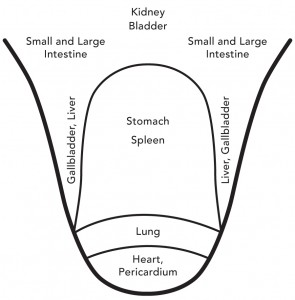What’s happening with the climate is happening within us. The well developed, holistic understanding Chinese medicine provides helps us understand that what’s happening in the world around is happening within us, and vice versa. Chinese medicine’s holism also recognizes that the big picture is a reflection of the little picture, and that the patterns that appear on the small scale are mirrored in what happens on a larger level.
One accessible way to begin to understand the state of our internal environment is Chinese tongue diagnosis. Our tongue is an external map of what is happening to our internal organs.
Just as it takes fortitude to look at the voluminous amounts of data that tells us unequivocally that the climate is rapidly destabilizing, looking at the information our tongue provides also requires conviction. A tongue that shows internal balance is pink, smooth on the top and sides, and without any colored coating or cracks. For many of us, our tongues won’t look like this, indicating various degrees of physical, mental and emotions imbalance. Just as avoiding the scientific consensus about what is happening to the climate won’t make the issues go away, ignoring the information our tongue provides won’t help with our health and healing. And the rapid warming and destabilizing of our planet is reflected in the often significant issues shown on our tongue.
Below is a picture of the tongue and the organs that correspond to each section. After looking at the picture, take some time to look at your tongue, noting the color, coating, texture, size and shape.

To begin to understand what your tongue is saying about your health and condition of your organs, use the information below.
- Raised red dots indicate advanced heat as well as toxicity. This is a sign of excess warmth pushing itself off of the surface of the tongue—the dots show that the heat has accumulated to toxic levels.
- Redness on the tongue indicates an excess of what Chinese medicine calls heat, which corresponds to over stimulation and inflammation. A severely red tongue that is dark or crimson red indicates more advanced heat.
- Color: When our organs are in balance, the whole tongue has a light pink color, from front to back and side to side.
- When the dots are very prominent, which can look like small growths, this indicates an even more significant accumulation of heat and toxicity, called fire toxins.
Coating: When there’s a healthy balance of moisture internally, the tongue has a slight, clear coating.
- A dry tongue occurs when there’s a lack of fluids.
- When there is internal heat, a thin, smooth white coat will appear, indicating that the fluids that were once clear are being cooked. This coating comes from what Chinese medicine calls dampness, which is an unhealthy accumulation of too much fluid.
- The next stage in the progression of heat and dampness is a smooth yellow coating, which indicates more heat than the white coating. The amount of yellow indicates the degree of heat, which corresponds to overstimulation and inflammation. The thickness of the coating indicates the amount of dampness.
Texture: When the organs are in balance, the tongue is smooth and flat throughout its entire length and width.
- Vertical cracking on the tongue indicates dryness and a lack of fluids, just as exposed soil when there’s too much sun without enough rain.
- Horizontal cracking indicates a lack of strength and vitality, which Chinese medicine calls Qi deficiency. Part of what our energy does is hold things together. When there’s not enough strength, things begin to pull apart and separate, creating horizontal cracks.
Size/Shape: A tongue indicating internal health is evenly rounded at the front and has a consistent width and thickness.
- A pointy tongue that is elongated at the tip indicates excess heat. It very often accompanies a red tip.
- Scallops on the side of the tongue indicate a lack of strength and Qi deficiency. Scallops are wavy indentations that occur where the tongue is pressing against the side of the teeth. Because our Qi is responsible for holding things in place, when it’s deficient, the sides of the tongue get puffy and push against the teeth, creating scallops.
- A puffy tongue also indicates deficient Qi. Just as the sides of the tongue get scalloped when there’s not enough strength to hold it in place, a puffy tongue can also come from a lack of energy.
- A dip in the tongue indicates a deeper level of weakness, call Yang deficiency, as there’s not enough deep strength to hold the tongue up. A dip in the back indicates a lack of our deepest reserves, called jing deficiency.
- A short tongue also indicates jing deficiency. This occurs when there is a complete absence of the back of tongue.
- A tongue that’s turned to the side is called a deviated tongue, which occurs because of too much internal movement, called internal wind. The degree of deviation speaks to the amount of internal wind.
For more information about tongue diagnosis, including what the different tongue qualities indicate about the condition of specific organs, see chapter 10 of The Yin and Yang of Climate Crisis.
